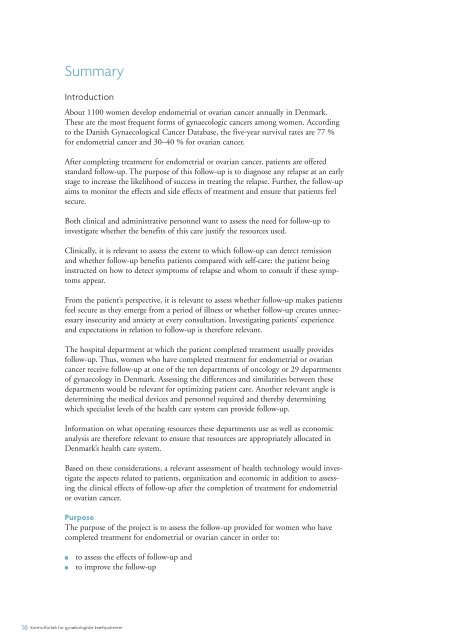Fuld rapport uden bilag, 107 s. - Sundhedsstyrelsen
Fuld rapport uden bilag, 107 s. - Sundhedsstyrelsen
Fuld rapport uden bilag, 107 s. - Sundhedsstyrelsen
Create successful ePaper yourself
Turn your PDF publications into a flip-book with our unique Google optimized e-Paper software.
summary<br />
introduction<br />
About 1100 women develop endometrial or ovarian cancer annually in Denmark.<br />
These are the most frequent forms of gynaecologic cancers among women. According<br />
to the Danish Gynaecological Cancer Database, the five-year survival rates are 77 %<br />
for endometrial cancer and 30–40 % for ovarian cancer.<br />
After completing treatment for endometrial or ovarian cancer, patients are offered<br />
standard follow-up. The purpose of this follow-up is to diagnose any relapse at an early<br />
stage to increase the likelihood of success in treating the relapse. Further, the follow-up<br />
aims to monitor the effects and side effects of treatment and ensure that patients feel<br />
secure.<br />
Both clinical and administrative personnel want to assess the need for follow-up to<br />
investigate whether the benefits of this care justify the resources used.<br />
Clinically, it is relevant to assess the extent to which follow-up can detect remission<br />
and whether follow-up benefits patients compared with self-care: the patient being<br />
instructed on how to detect symptoms of relapse and whom to consult if these symptoms<br />
appear.<br />
From the patient’s perspective, it is relevant to assess whether follow-up makes patients<br />
feel secure as they emerge from a period of illness or whether follow-up creates unnecessary<br />
insecurity and anxiety at every consultation. Investigating patients’ experience<br />
and expectations in relation to follow-up is therefore relevant.<br />
The hospital department at which the patient completed treatment usually provides<br />
follow-up. Thus, women who have completed treatment for endometrial or ovarian<br />
cancer receive follow-up at one of the ten departments of oncology or 29 departments<br />
of gynaecology in Denmark. Assessing the differences and similarities between these<br />
departments would be relevant for optimizing patient care. Another relevant angle is<br />
determining the medical devices and personnel required and thereby determining<br />
which specialist levels of the health care system can provide follow-up.<br />
Information on what operating resources these departments use as well as economic<br />
analysis are therefore relevant to ensure that resources are appropriately allocated in<br />
Denmark’s health care system.<br />
Based on these considerations, a relevant assessment of health technology would investigate<br />
the aspects related to patients, organization and economic in addition to assessing<br />
the clinical effects of follow-up after the completion of treatment for endometrial<br />
or ovarian cancer.<br />
Purpose<br />
The purpose of the project is to assess the follow-up provided for women who have<br />
completed treatment for endometrial or ovarian cancer in order to:<br />
■ to assess the effects of follow-up and<br />
■ to improve the follow-up<br />
16 Kontrolforløb for gynækologiske kræftpatienter

















